Posture: It Takes The Core!
One of the strangest gimmicks I’ve ever been introduced to in my professional career was in 2010. I was working in Boulder, CO and a salesperson brought in a “posture shirt” for us to try on. The idea was that it might be something useful for our patients. Oh man, was this shirt uncomfortable. It was restricting, non-breathable and made using my arms very challenging.
My only thought was: “Are we so lazy that we can’t work on our posture anymore? We now need a shirt?” Although posture “seems” challenging for some of us, it doesn’t have to be. Our body is brilliantly designed and we are born with the muscles we need. Yes, it might take a little effort at first, but once your posture muscles understand what “good posture” feels like, it’s like wearing your own magic shirt. So, here’s the question: What is posture and what makes it good?
The word posture is pretty vague. I know what it looks like in the body, but to put it into words is not easy. Here’s a few internet definitions of posture:
1. The position in which someone holds their body when standing or sitting (Google Chrome) – Ok, not that helpful
2. The attitude of the body (Medical Dictionary) – LOVE this one!
3. The position or bearing of the body whether characteristic or assumed for a special purpose (Merriam-Webster) – Vague!
I’ll be honest, it is much easier to understand posture from an active stand-point, so we will get to that in a bit. But, before we dive into movement, a little anatomy review is helpful to get us all on the same page.
Neurological Tracts
Without getting too science-y, we have primitive tracts or pathways in our body that give us feedback about being upright and erect. These tracts give signals to the spinal extensors, the muscles that run along the back of the spine. These signals tell the body to remain upright to ultimately provide a stable platform for our eyes to guide us through this world. Pretty cool.
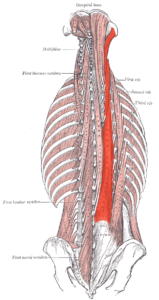 Spinal Extensors
Spinal Extensors
The spinal extensors run along the entire spine. And, there are a lot of them. We have cervical, thoracic and lumbar extensors.
- Cervical (Neck) – Splenius Capitis & Cervicis
- Cervical (Head) – Rectus Capitus Posterior Minor & Major, Oblique capitus
- Thoracic-Cervical – The large Erector Spinae Group: Ilicostalis, Longissimus and Spinalis.
- Lumbar-Thoracic-Cervical (deeper) – Semispinalis, Interspanalis and Multifidus
Together, these extensors keep us erect against gravity so that we can walk and move around. Even if we have rounded shoulders or a stooped posture, these extensors and signals from the neurological tracts ensure we aren’t crawling around on our hands and knees.
Ok, if these neurological tracts are so innate and continuously send signals to the spinal extensors, why do so many of us struggle with posture? Good question. Just because we are upright, does not mean it looks good. So, what makes posture GOOD?
Core Muscles of Posture
Good posture takes core control. The true core. This includes your scapula, deep abdominals and glute muscles. Oh, and the diaphragm!
Scapula (Shoulder Blade) Muscles
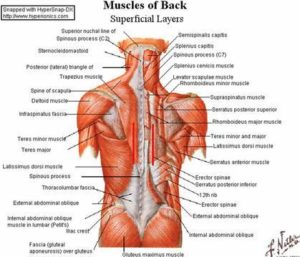 The main shoulder blades muscles that help with posture are:
The main shoulder blades muscles that help with posture are:
- Latissimus Dorsi
- Middle & Lower trapezius
- Rhomboid Major & Minor
- Serratus Anterior
These muscles help anchor the shoulder blade on the rib cage, while opening the chest to resolve the rounded shoulder, slouched spine position.
The Diaphragm
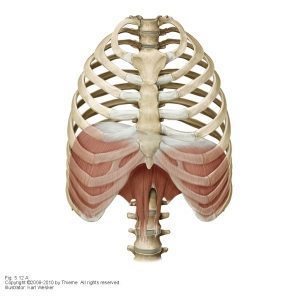 This is our primary breathing muscle. It expands along the lower 6 ribs, attaches to the spine and gives stability to the trunk. It’s a major player in core control, but most of us do not breathe with this muscle. If you want to start by fixing ONE thing with your posture, start here. BREATHE with your primary breathing muscle. Not only will help with your posture, but also your mood, stress and energy. That’s a lot of bang for your buck!
This is our primary breathing muscle. It expands along the lower 6 ribs, attaches to the spine and gives stability to the trunk. It’s a major player in core control, but most of us do not breathe with this muscle. If you want to start by fixing ONE thing with your posture, start here. BREATHE with your primary breathing muscle. Not only will help with your posture, but also your mood, stress and energy. That’s a lot of bang for your buck!
Deep Abdominals
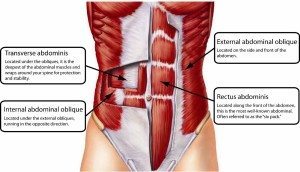 We have 4 layers of abdominals, but only the inner two give stability to the spine and trunk. Activation of these muscles allows the shoulders to stack over the hips.
We have 4 layers of abdominals, but only the inner two give stability to the spine and trunk. Activation of these muscles allows the shoulders to stack over the hips.
- Internal Abdominal Oblique
- Transverse Abdominis
The Glute Muscles
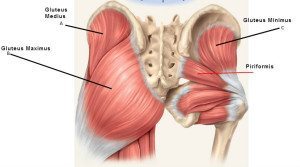 Without your glutes, your trunk is wobbly. One of my favorite researchers, Christopher Powers, PhD, PT said it brilliantly:
Without your glutes, your trunk is wobbly. One of my favorite researchers, Christopher Powers, PhD, PT said it brilliantly:
“Imagine your abdominals/trunk are a vase. If you place the vase on a wobbly surface (weak glutes), that vase is unstable. But, if you place that vase on a steady surface, the vase is stable.”
Glutes are VITAL for true core control, thus posture. The three key muscles here are:
- Gluteus Maximus, Medius & Minimus
I posed this question earlier: “If we have these tracts, spinal extensors and trunk muscles to give us good posture, why do so many of us struggle with it?”
Answer: Technology and lack of healthy movement. We are sitters. We are sitters at a computer, or a mobile device or a TV. And, our bodies weren’t designed to sit. But, most of us do it ALL DAY LONG. Although sitting is not ideal, it’s can’t take full blame. Because the act of sitting itself will not give you poor posture. It’s the WAY we sit.
Consider your posture right now. Are you slouched? Is your head looking down and your spine rounded? Is your core engaged and shoulder blades anchored down your back? How does it feel to sit upright? It might feel a little funny at first, but I guarantee it looks a lot better than any of these positions. And, your spine is in a happier place too.
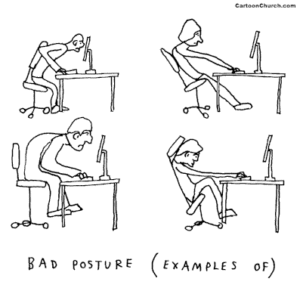
In addition to fixing your sitting posture, what are you doing to counter-act that sitting? Even a brisk walk is SOMETHING. And, something is better than nothing. Our bodies were designed for movement. Just remember to think of your core and posture while on that walk.
So, forget the posture shirt and gimmicks. Find your core to help you find that healthy feeling of good posture.
Here is a quick video with some easy exercises for good posture. Perform 5-10 repetitions of each exercise a few times a day and in one week you’ll notice the difference.
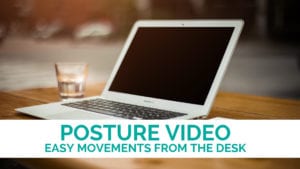 Posture Video: Easy Movement From the Desk
Posture Video: Easy Movement From the Desk
© 2017 and Beyond. ALL BLOG CONTENT at duncansportspt.com by Lori Duncan PT
ABOUT THE AUTHOR
 Lori Duncan, DPT, MTC, CPT is a respected Physical Therapist, Manual Therapist and Pilates instructor in Lafayette, CO. Lori is passionate about preventive physical therapy and education and is a nationally recognized presenter. She can be reached at [email protected]. You can also follow Duncan Sports Therapy + Wellness on Facebook & Instagram for more free tips and information.
Lori Duncan, DPT, MTC, CPT is a respected Physical Therapist, Manual Therapist and Pilates instructor in Lafayette, CO. Lori is passionate about preventive physical therapy and education and is a nationally recognized presenter. She can be reached at [email protected]. You can also follow Duncan Sports Therapy + Wellness on Facebook & Instagram for more free tips and information.


Lori love all of your insight would love to work with you but live in ct. read several of your posts
about the piriformis issue.four weeks ago after running i woke up and after walking 100 yards my butt was in so much pain i had to bend over to relieve the pain and each progressive distance distance between the pain was shorter until i had to stop.had exrays on pelvic and lower back everything came back clean.been working with a chiropractor for four weeks no adjustments just some stretching and trigger point work with no improvement.your approach sounds like the most logical with the hip and gluteus not firing properly.starting doing the exercises you recommend but would like to know if you could advise me on number of reps and frequency,every day twice a day 3x a week not sure.
thanks
Hi!
Thanks for reading and glad it makes sense. I usually state somewhere between 10-20 reps, 1-2x/day of each exercise. We respond to strength gains by moderate fatigue, so try and make those muscles burns a bit. Yes, if you don’t feel yourself running from those glutes, it is likely a problem. Hope they help you feel better!
This isn’t specific to the article, but I wanted to say thank you for your AMAZING online course (Strengthening Core Stability)! It is honestly life changing (largely personally, though of course professionally too)! I made sure to look up your blog as soon as I finished. 🙂
So, thank you! I’m looking forward to future blog entries.
Hi Julie!
Well this just made me smile… A LOT! I’m so happy it was worth your time and feels like new information for you and your patients.
I agree with Julie. I also just finished your online course and have about a dozen sticky notes written for new exercise ideas to try with my patients. Great practical info that makes so much sense. You also put the concepts together with the appropriate exercises (handouts included, thank you!!) which is so helpful when trying to come up with a specific treatment plan. Love the blog articles and have shared them with colleagues.
HI Kristi,
Well, that makes me so happy to hear that is practical for you in the clinic. That’s the whole point! Thank you for sharing and reaching out.
LORI, I have been doing your two performs exercises for the past 3 weeks. They do help, but still have issues when I do a lot of bending, especially down the side of my hip (can’t even lay on right side) and hurts in knee area. I am 75, try to walk mile and a half every day and used to do Total Gym- 20 repetitions each leg laying on back, belly and both sides. Quit doing them when I started focusing on performs and leg raises. In the summers we go rock hunting and going up hills was just hurting so much in the back/sides of my hip, had to quit… Am hoping these exercises help me get over this!! Thank you for all the informative blog posts – threw out tennis ball & roller, so glad I found you before I had used these for months!! Marilyn
Hi Marilyn,
Glad you are getting some relief. If you don’t feel at least 50% better in a few weeks, make sure you get your spine checked for any contributing factor. At the top of the website it says “Pilates on Demand.” Click on that and then you can choose the glute video for purchase. Thanks for reaching out.
One last thing, where do I find your online class list?